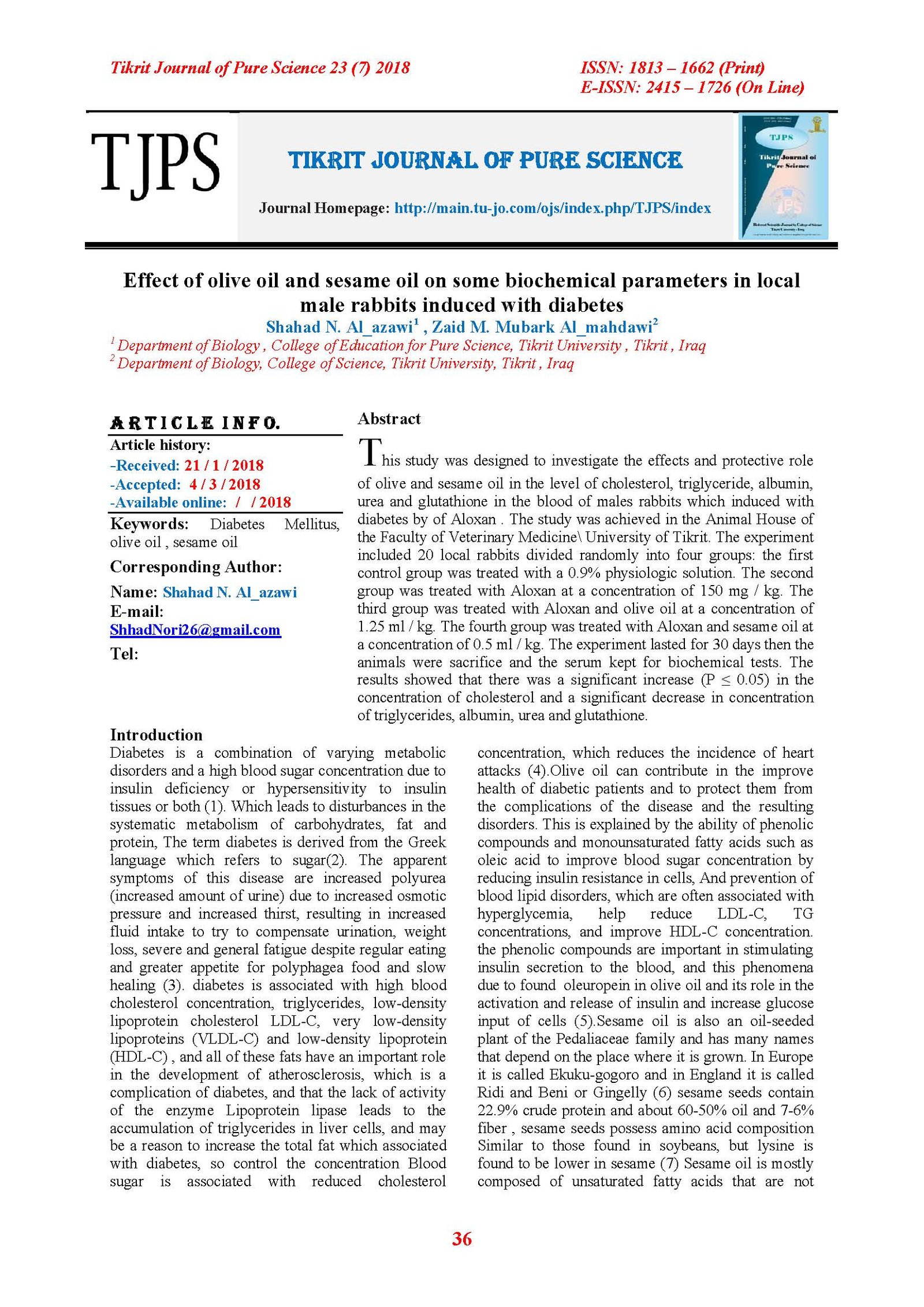Effect of olive oil and sesame oil on some biochemical parameters in local male rabbits induced with diabetes
Main Article Content
Abstract
This study was designed to investigate the effects and protective role of olive and sesame oil in the level of cholesterol, triglyceride, albumin, urea and glutathione in the blood of males rabbits which induced with diabetes by of Aloxan . The study was achieved in the Animal House of the Faculty of Veterinary Medicine\ University of Tikrit. The experiment included 20 local rabbits divided randomly into four groups: the first control group was treated with a 0.9% physiologic solution. The second group was treated with Aloxan at a concentration of 150 mg / kg. The third group was treated with Aloxan and olive oil at a concentration of 1.25 ml / kg. The fourth group was treated with Aloxan and sesame oil at a concentration of 0.5 ml / kg. The experiment lasted for 30 days then the animals were sacrifice and the serum kept for biochemical tests. The results showed that there was a significant increase (P ≤ 0.05) in the concentration of cholesterol and a significant decrease in concentration of triglycerides, albumin, urea and glutathione
Article Details

This work is licensed under a Creative Commons Attribution 4.0 International License.
Tikrit Journal of Pure Science is licensed under the Creative Commons Attribution 4.0 International License, which allows users to copy, create extracts, abstracts, and new works from the article, alter and revise the article, and make commercial use of the article (including reuse and/or resale of the article by commercial entities), provided the user gives appropriate credit (with a link to the formal publication through the relevant DOI), provides a link to the license, indicates if changes were made, and the licensor is not represented as endorsing the use made of the work. The authors hold the copyright for their published work on the Tikrit J. Pure Sci. website, while Tikrit J. Pure Sci. is responsible for appreciate citation of their work, which is released under CC-BY-4.0, enabling the unrestricted use, distribution, and reproduction of an article in any medium, provided that the original work is properly cited.
References
1. Ozougwu, J. (2013). The pathogenesis and pathophysiology of type 1 and type 2 diabetes mellitus. Journal of Physiology and Pathophysiolog ; 4(4) : 46-57.
2. Piero, M. (2014). Diabetes mellitus a devastating metabolic disorder. Asian Journal of Biomedical and Pharmaceutical Sciences. 04 (40) ,1-7.
3. Barrett, K. (2010). Ganong ,s Review of Medical Physiology, 23rd edition. Mc Grow Hill Lange.p:714.
4. Rosenbloom, A. (2007). Hyperglycemic crises and their complications in children. J. Pediatr Endocrinol Metab; 20(1): 5-18.
5. Gonzalez,M. (2007). Hypoglycemic activity of olive leaf. J. Planta Med; 58: 313-315.
6. Gill, (1992) ''Ethno medical uses of plants in Nigeria'', Uniben press, Edo State Nigeria, p.212. nian J. of pharmacy. Res., 8(2):101-105.
7. Mamputu and Buhr, (1995). Effect of substituting sesame meal for soybean meal on layer and broilerper for mance .Poult .Sci.74;672-684.managing stored product insects. Ann. Rev. Entomol. 55: 375-397
8. Naficeh, Mannan, (2009). The contents of sesamol in Iranian sesame seeds. Ira.
9. Tadoa, I. (2005). Deficiency of the very low density lipopotein (VLDL) receptors in alloxan-induced diabetic rats: insulin dependency of the VLDL receptor. Endocrinology, 146(8): 3286-3294.
10. Lenich, A. (2010). Effect of dietary cholesterol and alloxan diabetes on tissue cholesterol and apolipoprotein E mRNA levels in the rabbit. J. Lipids Res., 32(3): 432-438.
11. Hori, M.(2004) Acyl-Co-A: cholesterol acyl transferase-2 (ACAT-2) is responsible for elevated intestinal ACAT activity in diabetic rats. Arterioscler. Thromb. Vasc. Biol., 24: 1689-1695.
12. Kris P. (2009).Monounsaturated fatty acids and risk of cardiovascular disease. Circula- tion. 100: 1253-8.
13. Pignatelli, P.(2012).Immediate antioxidant and antiplatelet effect of atorvastatin via inhibition of Nox2. Circulation. 126:92–103.
14. Kaleem, M.(2005). Protective effect of Piper nigram and Vinca rosea in alloxan induced diabetic rats. Indian. J. Physiol. Pharmacol., 49(1): 65-71.
15. Bilbis, L.S. (2012). Hypoglycemic and hypolipidemic effects of aqueous extract of Arachis hypogaea in normal and alloxan induced diabetic rats. Phytomedicine, 9 (6): 553-555.
16. Nelson, D.L. and Cox, M.M.(2005). Lehninger Principles of Biochemistry. 4th ed., W.H. Freeman Company, New York, USA., PP. 430, 807, 887-904.
17. Marques, A. (2011). Effect of flaxseed (Linum usitatissimum L.) prepared by different methods on the biological response of rats. Revista de Nutrição,. 24, . 1, p. 131-141.
18. Bolkent, S.(2004). The morphological and biochemical effects of glibornuride on rat liver in experimental diabetes. Human and Experimental Toxicology, 23(5): 257-264.
19. Wainstein, J.(2012). Olive leaf extract as a hypoglycemic agent in both human diabetic subjects and in rats. J Med Food. 15(7):605-10.
20. Choi, A. (2008). Isolation and characterization of multiple abundant lipid transfer protein isoforms in developing sesame seeds. Plant Physiolog and Biochemistry,46(2), 127.
21. Rashid, M. (2015). Comparative effect of olive oil and fish oil supplementation in combating gentamicin induced nephrotoxicity in rats, Indian J. Clin. Biochem. 20 109–114.
22. Chandramohan, G.; Al-Numair, K. S. and Pugalendi, K. V. (2013). Effect of 3-hydroxymethyl xylitol on hepatic and renal functional markers and protein levels in alloxan-diabetic rats.Afr. J. Biochem. Res., 3(5): 198-204
23. Bhuvaneswari P, Krishnakumari S.(2012). Nephroprotective effects of ethanolic extract of Sesamum indicum seeds in streptozotocin induced diabetic male albino rats. Int J Green Pharm.6:330-335.
24. Delarue, C. (2011). “N-3 Long Chain Polyunsaturated Fatty Acid. A Nutritional Food to Prevent Insulin Resistance Associated to Type-2 Diabetes and Obesity,” Reproduction Nutrition Development, 44, pp. 289-299.
25. Infers, H.(2010). The production of ascorbate and glutathione against microsomal lipid peroxidation is dependent on vitamin E. Eur J Biochem.174:353.
26. Mahendra, D.(2014). Oxidative Stress in Type II Diabetes Mellitus. Biomedical Research 2014; 25 (1): 84-87
27. Siems, L. (2006). Age-associated analysis of oxidative stress parameters in human plasma and erythrocytes. Free Radical Research 40(5): 495-505.
28. Scalbert A, Williamson G. (2010). Dietary intake and bioavailability of polyphenols. J Nutr.130:2073–85.
